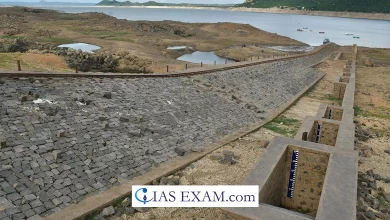India’s Future with Natural Gas
[GS Paper 3 – Indian Economy, Infrastructure, Energy]
Context – The Ministry of Petroleum has announced to constitute a committee headed by energy expert Kirit Parekh to review the domestic natural gas pricing in India.
Prime Minister Narendra Modi has expressed his desire to raise the share of gas in the country’s energy mix from 6.2% at present to 15% by 2030. This will help India in meeting its 2070 net-zero carbon emission goals.
About Natural Gas
- It is a fossil fuel source primarily composed of methane and is the cleanest fossil fuel among all the available fossil fuels at present.
- Natural Gas is used as a feedstock in the manufacture of pesticides, fertilizers, plastics and other commercially important organic chemicals while also being used as a fuel for electricity generation, heating purposes in industrial and commercial units.
- It is also used for cooking domestic households and transportation fuel for vehicles.
Importance of Natural Gas
- Energy Efficient: This fossil fuel produces more energy than any of the fossil fuels in terms of calorific value.
- Cleaner fuel: It is a superior fuel as compared with coal and other liquid fuels being an environment-friendly, safer and cheaper fuel.
- Economy of use: The fossil fuel is much cheaper compared with petrol or Diesel.
- Emission commitments: Under the COP 21 Paris Convention, India has committed that it would reduce carbon emission by 33%-35% of 2005 levels.
- Diverse applications: The fossil fuel or Natural Gas can be used as domestic kitchen fuel, fuel for the transport sector as well as a fuel for fertilizer industries and commercial units.
- Supply chain convenience: It is supplied through pipelines just like we get water from the tap. As a result, it is not needed to store cylinders in the kitchen and thus save space.
- Pacing up the progress line: World over, switching to natural gas is bringing commendable results. According to IEA’s latest reports, the electricity produced by natural gas worldwide was more than that of coal for the first time ever.
Scenario of Natural Gas in India
- Domestic Gas Source: Domestic gas in India is sourced from the oil & gas fields located at western and southeastern areas viz. Hazira basin, Mumbai offshore & KG basin as well as North East Region (Assam & Tripura).
- Import of Liquefied Natural Gas (LNG): To meet with the gas demands, LNG is imported through the Open General License (OGL) in the country. Presently, India is having six operational LNG regasification terminals at Dahej, Kochi, Mundra, Ennore etc.
- Gas Pipelines : The infrastructure projects concerning gas pipelines is an economical and safe mode of transporting natural gas by connecting gas sources to gas-consuming markets. The interconnection through the National Gas Grid has been envisaged to ensure the adequate availability and equitable distribution of natural gas in all parts of the country
- Pricing: Since 2014, India has linked local gas prices to a formula tied to global benchmarks in order to incentivize gas producers and boost local input, including Henry Hub, Alberta gas, NBP and Russian gas.
- India began fixing the ceiling prices of gas produced from ultra-deep water in 2016 and challenging fields and allowed marketing freedom to the operators of these fields.
Kirit Parikh Committee
- Objective: The committee is constituted with an objective to suggest a market oriented, transparent and reliable pricing regime for India’s long term vision for ensuring a gas based economy.
- Members: Apart from Kirit Parakh, the committee will include members from the fertilizer ministry, as well as gas producers and buyers. Four of the six members are from the public sector.
Challenges for India’s Natural Gas Reserves
- Harsh topography: The IHS CERA reports states that India has undiscovered gas resources of approximately 64 TCF but, majority of the amount is located in harsh topography and complex geology. Therefore, these reserves are difficult to locate.
- Distant from the market: They are still difficult to be brought into the market on economically viable terms even after they are located somehow because the cost of creating the development and production infrastructure will be enormous.
- Heavy Budget: India, probably is a high-risk exploration play as there exists inherent geologic, technical, and economic obstacles to achieving commercial success
- Administered Pricing: There also remains substantial constraint of administered pricing petroleum companies who have reduced their exploration budgets under pressure to shift away from fossil fuels.
Conclusion
With the emergence of the Ukrainian Crisis, the global energy market has undergone a profound transformation. India undoubtedly has made credible progress towards clean energy but however, it has a long way to go before it can rid itself from fossil fuel.





.png)



